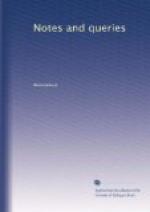It would be interesting to know to what act of parliament Arnold’s citizens refer, and whether it has ever been repealed. It is curious to notice, too, that the danger from infuriated beasts running wild through the streets is not amongst the evils of the system represented. They go further, however, and forbid even the killing within the city.
Moreover, it would really seem that the swan was not then a mere ornamental bird, either alive or dead, but an ordinary article of citizen-dinners, it being classed with “gies and dowks” in the business of the poulterer. At the same time, no mention being made of swine in any of these ordonnances or petitions, would at first sight seem to show that the flesh of the hog was in abhorrence with the Catholic citizen, as much perhaps as with the Jews themselves; at any rate, that it was not a vendible article of food in those days. When did it become so? This conclusion would, however, be erroneous; for amongst “the articles of the good governauce of the cite of London” shortly following we have this:—
“Also yf ony persone
kepe or norrysh hoggis, oxen, kyen, or
mallardis within the ward,
in noyoying of ther neyhbours.”—p.
91.
The proper or appointed place for keeping hoggis was Hoggistone, now Hoxton; as Houndsditch[2] was for the hounds.
There is another among these petitions to the Lord Mayor and corporation, worthy of notice, in connection with sanatory law.
“Also in avoydig ye abhomynable savours causid by ye kepig of ye kenell in ye mote and ye diches there, and i especiall by sethig of ye houndes mete wt roten bones, and vnclenly keping of ye houdes, wherof moche people is anoyed, soo yt when the wynde is in any poyte of the northe, all the fowle stynke is blowen ouer the citee. Plese it mi Lord Mair, Aldirmen, and Comen Coucell, to ordeigne that the sayd kenell be amoued and sett in so other couenient place where as best shall seme them. And also that the said diches mai be clensed from yere to yere, and so kepte yt thereof folowe non annoyaunce.”—p. 87.
Of course “Houndsditch” is here meant; but for what purpose were the hounds kept? And, indeed, what kind of hounds were they, that thus formed a part of the City establishment? Were they bloodhounds for tracking criminals, or hounds kept for the special behoof and pleasure of the “Lord Mair, Aldermen, and Comen Cousel?” The Houndsditch of that time bore a strong resemblance to the Fleet ditch of times scarcely exceeding the memory of many living men.
I come now to the passages relating to the clergy.




